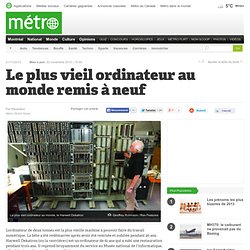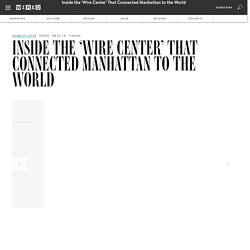

Theretronaut : 1935: IBM (source:... Sept 9, 1947 The First "Computer Bug" 1960 Who Made That Escape Key? Hedy Lamarr, star hollywoodienne et pionnière du WiFi. Le WiFi, dont vous vous servez probablement pour lire cet article, fêtera ses quinze ans cette année.

Mais la technologie sur laquelle il repose remonte aux années 1940, et nous la devons aux travaux de deux scientifiques du dimanche : un compositeur américain et une actrice autrichienne, coqueluche de l’âge d’or d’Hollywood. Au rayon des inventrices inspirées et détonantes, on ne trouve pas que des scientifiques passionnées. La femme qui est à l’origine de la technologie sur laquelle repose le WiFi était une Européenne devenue célèbre à Hollywood : Hedy Lamarr, « plus belle femme du monde » des années 1930, comédienne aux multiples facettes, croqueuse d’hommes, aventurière et, donc, esprit visionnaire. Une vie de roman Quand le public commence à entendre parler de Hedy Lamarr, sa vie a déjà tout du roman, comme seule l’Europe de la Seconde Guerre mondiale peut en produire.
Née en 1914, Hedy est, dès le début de sa vie, placée sous le signe de la guerre. Apple's First Public Demonstration of the Mac, Unseen Since 1984. Apple Mac 1984. Alan Turing @ The Science Museum. We’ve finally made it to the Science Museum to see an exhibition dedicated to life and legacy of one of our personal heroes, the British mathematician, philosopher and computer scientist Alan Turing.

Titled , the show celebrates the 2012 centenary of Turing’s birth. Most famous for his input in decrypting German military messages during WWII by breaking the code of the machine, Alan Turing was also one of the founders of Artificial Intelligence and of the first electronic ‘universal’ computer ( , on display). Interested in whether cognitive mind can exist outside human body, another of his groundbreaking proposals was a test devised to established whether computers were capable of independent thinking. No machine has yet officially passed the Breaker of not just science-, but also the 50s society codes, Turing’s personal life made a tragic turn when a conviction of gross indecency due to his homosexuality and a forced chemical castration (this was only 60 years ago!) Alan Turing's life and legacy. Facebook?! Twitter?! Instagram?! We Did That 40 Years Ago.
A Brief History of the Computer - Photo Essays. AT&T Archives: The Twins - AT&T Tech Channel. IBM Ad for SAGE, A Massive Cold War Air Defense System (1960) Computer History Museum. Le plus vieil ordinateur au monde remis à neuf. L’ordinateur de deux tonnes est la plus vieille machine à pouvoir faire du travail numérique.

La bête a été redémarrée après avoir été remisée et oubliée pendant 20 ans. Harwell Dekatron (ou la «sorcière») est un ordinateur de 61 ans qui a subi une restauration pendant trois ans. Il reprend bruyamment du service au Musée national de l’informatique, à Buckinghamshire, au Royaume-Uni. «C’est merveilleux de voir l’ordinateur fonctionner à nouveau. Le voir en action, c’est observer le fonctionnement interne d’un ordinateur – ce qui est impossible de nos jours. – Kevin Murrell, restaurateur et administrateur au Musée national de l’informatique. Conçu pour être fiable, mais pas rapide La machine (il n’y en a que 12 comme elle dans le monde) a été utilisée dans les années 1950 à l’Établissement de recherche en énergie atomique à Oxfordshire pour de la modélisation mathématique.
Aussi dans Techno: Partager: Babbage Difference Engine in Gigapixel. The Babbage Difference Engine in High Resolution Photography. Inside the ‘Wire Center’ That Connected Manhattan to the World. Back in the days when people used landline telephones strung together with copper wire, most calls into lower Manhattan passed through a 31-story art deco building at 140 West Street.

Behind its gilded doors lay the cables and switches that connected landlines throughout southwest Manhattan. Just a handful of people work there today, and much of the building is being converted to condos. But the copper wire remains. “You’d never guess in 100 years that behind that door is a telephone vault,” says Christopher Payne. Payne is fascinated by obsolete technology and outdated factories. In the heyday of copper landlines, Verizon employees worked on every floor of the building, which was designed for AT&T in 1927. Payne spent two days there in July. Go Back to Top.